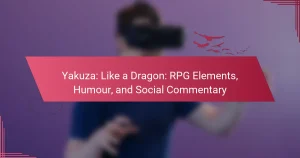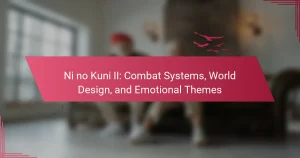Hades stands out in the indie game scene for its engaging narrative structure and captivating art style. The game combines roguelike mechanics with rich character-driven storytelling. Its vibrant visuals and fluid animations enhance player immersion. This article explores Hades’ success factors, including its innovative gameplay, dynamic storytelling, and artistic design.
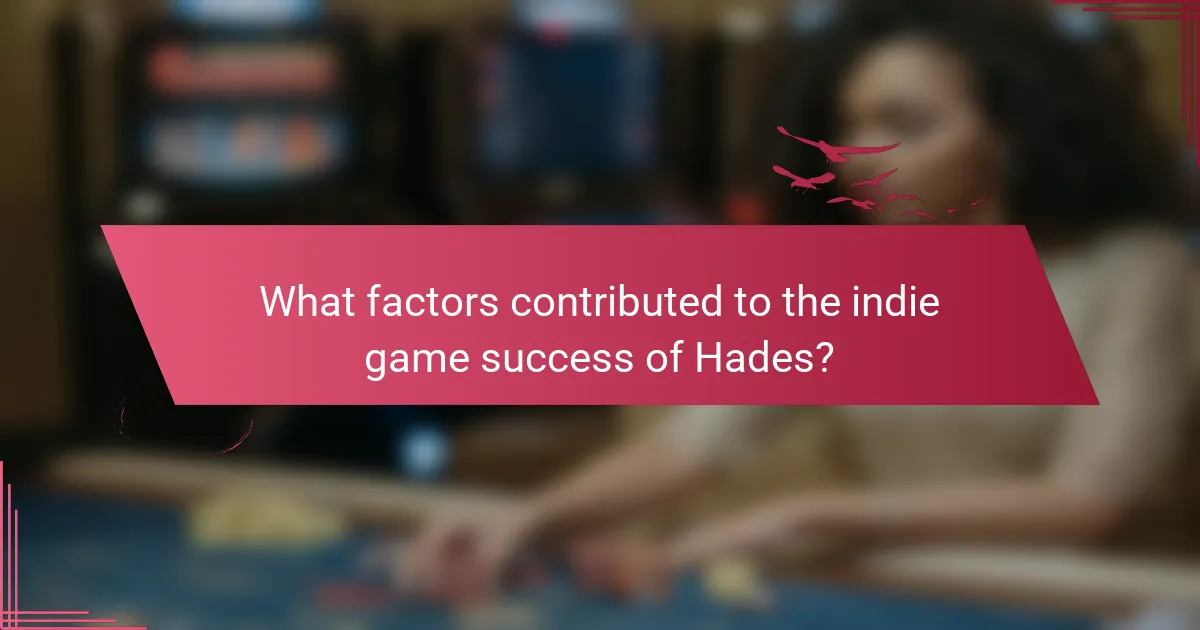
What factors contributed to the indie game success of Hades?
Hades achieved indie game success due to its innovative narrative structure and striking art style. The game features a unique blend of roguelike mechanics with a rich story, allowing players to experience character-driven arcs with emotional depth. The art style combines vibrant colors and fluid animations, enhancing the immersive experience. Furthermore, critical acclaim and community support played significant roles in its popularity, resulting in strong sales and awards. The game’s ability to balance gameplay and storytelling sets it apart in the indie game landscape.
How did Supergiant Games leverage community feedback for Hades?
Supergiant Games effectively utilized community feedback to enhance Hades, resulting in a refined gameplay experience. They actively engaged players through Early Access, allowing for iterative improvements based on player input. This approach led to significant adjustments in balance, narrative depth, and overall design. The incorporation of player suggestions fostered a sense of community ownership, which contributed to the game’s success. Supergiant’s commitment to listening to their audience exemplifies a unique attribute of their development philosophy.
Which marketing strategies were most effective for Hades?
Hades effectively utilized community engagement, influencer partnerships, and narrative-driven marketing strategies. These methods built anticipation and fostered a loyal player base. The game’s unique art style and compelling storytelling were highlighted in promotional materials, attracting attention. Engaging with players through social media and live streams created a sense of community and enhanced visibility.
What role did awards and recognition play in Hades’ success?
Awards and recognition significantly contributed to Hades’ success by validating its innovative gameplay and storytelling. The game received numerous accolades, including the BAFTA Games Award for Best Game, which highlighted its artistic achievements and narrative depth. These honors not only increased visibility but also bolstered player trust and interest. As a result, Hades became a benchmark for indie games, showcasing how critical acclaim can enhance commercial success and community engagement.
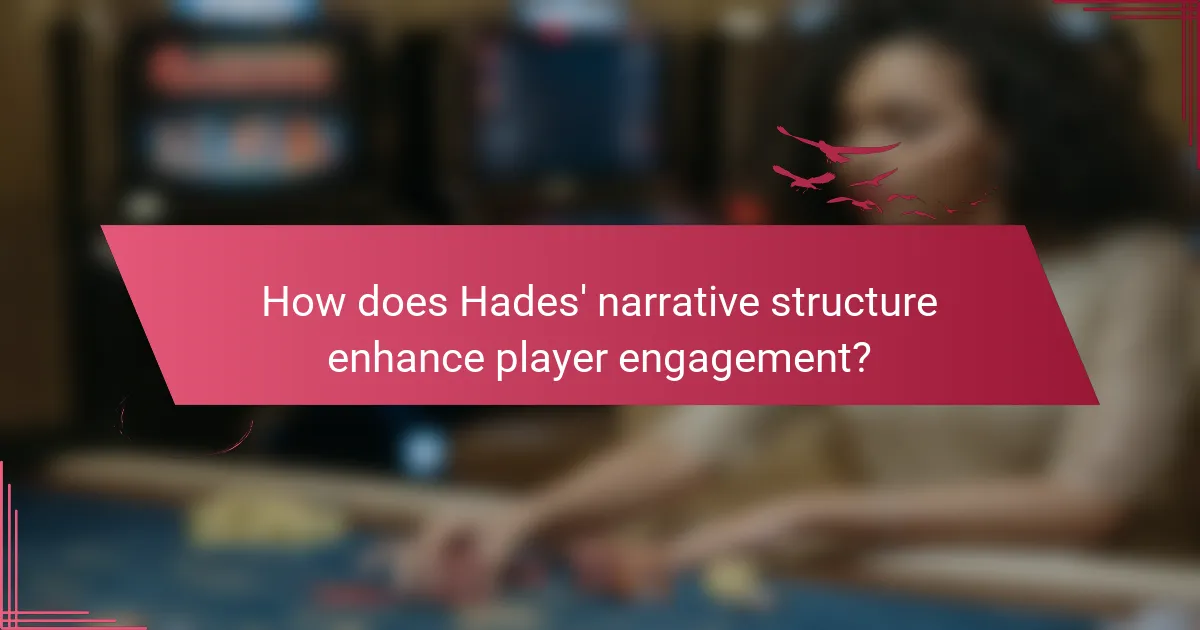
How does Hades’ narrative structure enhance player engagement?
Hades’ narrative structure significantly enhances player engagement through its dynamic storytelling and rich character development. The game’s use of a roguelike format allows players to experience varied interactions with characters, creating a sense of discovery. Each run reveals new dialogue and story elements, which deepens emotional investment. The integration of mythology with personal narratives adds layers to character arcs, making them relatable. Additionally, the cyclical nature of gameplay encourages players to explore different outcomes, enhancing replayability and engagement.
What are the key components of Hades’ storytelling approach?
Hades employs a unique storytelling approach that intertwines character development, player choice, and mythological themes. The narrative unfolds through dynamic interactions with characters, enhancing emotional engagement. Players experience branching dialogue paths that influence relationships, creating a sense of agency. The integration of Greek mythology provides depth, while the game’s art style visually complements the storytelling, immersing players in a vibrant underworld.
How does character development influence the narrative in Hades?
Character development significantly enhances the narrative in Hades by creating emotional depth and player engagement. Each character embodies unique traits and backstories, which enrich the player’s experience. For example, the relationships between Zagreus and other characters evolve through dialogue and interactions, revealing motivations and conflicts. This dynamic storytelling encourages exploration and investment in the game’s world. The integration of character arcs with gameplay mechanics also reinforces the narrative, making each encounter meaningful. As a result, Hades demonstrates how character development can elevate narrative structure and player immersion.
What techniques does Hades use to incorporate player choice into its story?
Hades employs various techniques to integrate player choice into its narrative. The game features branching dialogue options that allow players to shape relationships with characters. Additionally, the choice of weapon and upgrades affects gameplay and story outcomes. The narrative adapts based on player decisions, enhancing immersion and replayability. This dynamic storytelling approach reflects Hades’ unique attribute of combining action with meaningful player agency.
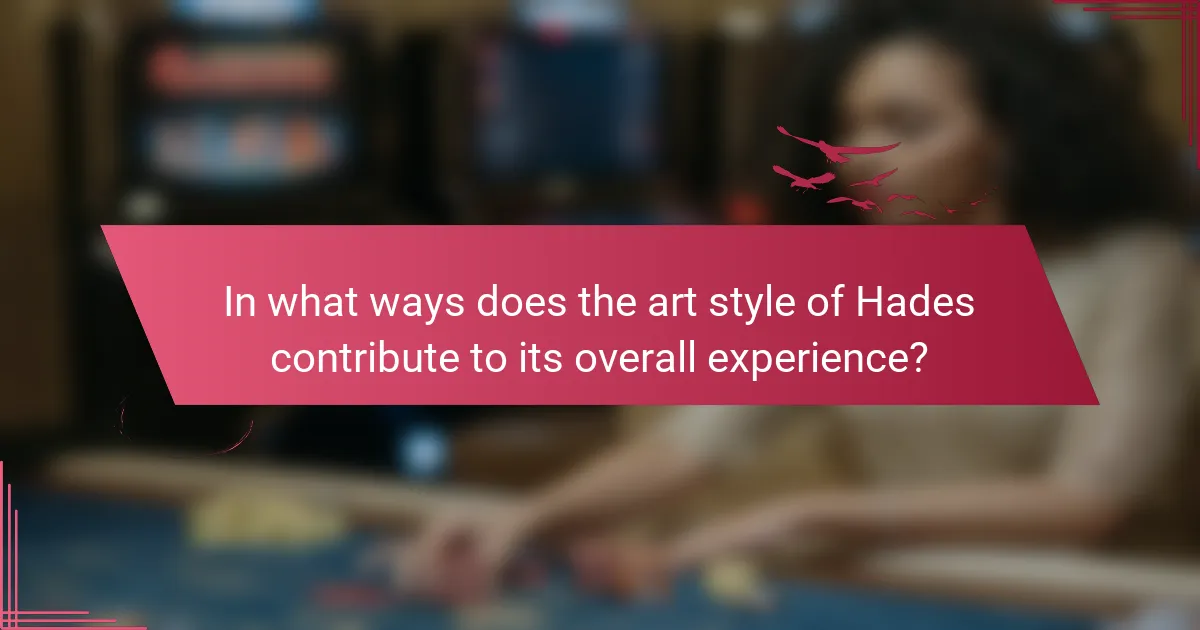
In what ways does the art style of Hades contribute to its overall experience?
The art style of Hades significantly enhances the overall experience through its vibrant visuals and dynamic animations. The use of bold colors and intricate character designs immerses players in the mythological underworld. Unique attributes, such as the fluidity of combat animations, create a sense of urgency and excitement. The art direction also complements the narrative structure, reinforcing themes of fate and choice with symbolic imagery. As a result, the aesthetic elements work cohesively to deepen emotional engagement and player immersion.
How does the visual design reflect the themes of Greek mythology?
The visual design of Hades reflects themes of Greek mythology through its vibrant art style and character representations. The game employs a color palette that evokes the underworld, emphasizing contrasts between light and dark to symbolize life and death. Character designs draw inspiration from mythological figures, showcasing unique attributes that highlight their stories and relationships. The use of Greek motifs in environments reinforces the narrative structure, immersing players in a mythic journey. Overall, the design encapsulates the essence of Greek mythology while enhancing gameplay and storytelling.
What artistic techniques were employed to create Hades’ unique aesthetic?
Hades employs vibrant color palettes, dynamic character designs, and hand-painted backgrounds to create its unique aesthetic. The use of Greek mythology influences the art style, blending traditional motifs with modern animation techniques. Each character features distinct visual traits that reflect their personalities and stories, enhancing narrative depth. The game’s isometric perspective allows for intricate level design, creating immersive environments that draw players into the underworld setting.
How does the animation style impact gameplay and immersion?
The animation style in Hades significantly enhances gameplay and immersion by creating a dynamic and visually engaging experience. The fluid character movements and expressive animations draw players into the narrative, making them feel connected to the story and characters. This unique attribute of the animation style contributes to the game’s overall emotional impact, allowing players to experience the intensity of combat and the depth of character interactions. As a result, the combination of art style and gameplay mechanics fosters a rich, immersive environment that keeps players engaged.
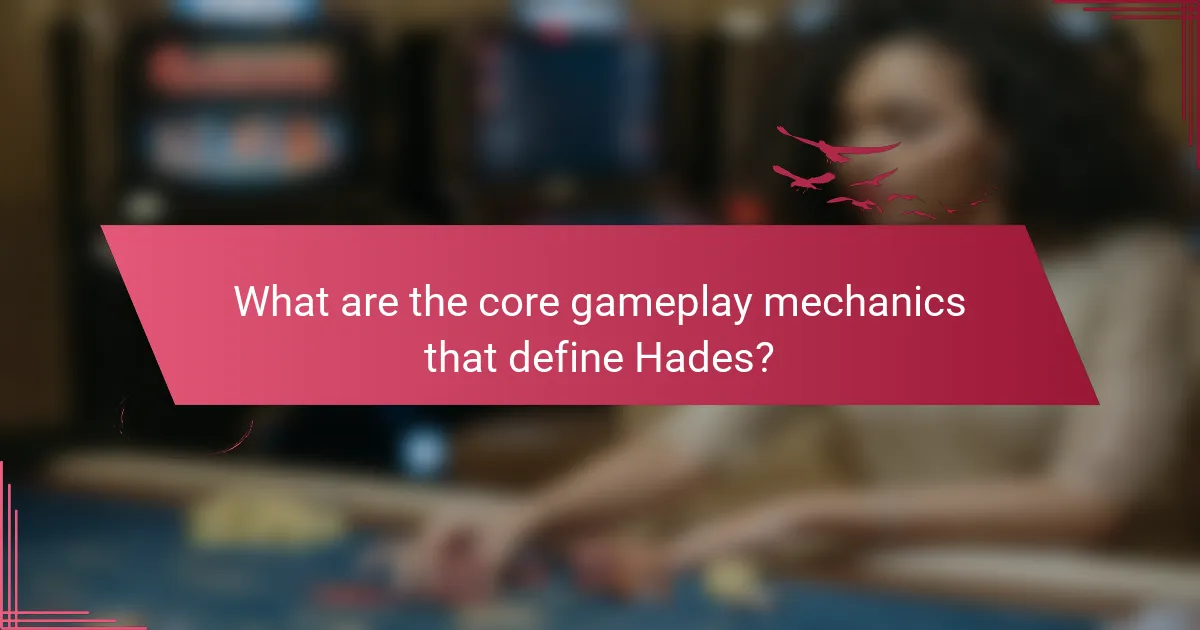
What are the core gameplay mechanics that define Hades?
Hades features core gameplay mechanics that include rogue-like elements, skill-based combat, and a rich narrative structure. Players navigate procedurally generated levels while battling various enemies using a combination of weapons and abilities. The game emphasizes player choice through its upgrade system, allowing for unique builds and strategies. Additionally, the story unfolds through interactions with characters, enhancing the immersive experience of the underworld setting.
How do the combat systems in Hades differ from traditional roguelikes?
The combat systems in Hades differ from traditional roguelikes by emphasizing real-time action and narrative integration. Unlike many roguelikes that rely on turn-based mechanics, Hades features fluid combat that encourages player engagement through skillful dodging and timing.
Additionally, Hades incorporates a unique narrative structure where the story evolves with each run, enhancing player motivation. Players receive dialogue and character interactions that change based on their progress, creating a deeper emotional connection compared to static narratives in traditional roguelikes.
The variety of weapon forms and upgrades available in Hades also sets it apart, offering players diverse combat styles and strategies. This flexibility contrasts with the often rigid systems found in conventional roguelikes, promoting replayability and personalized gameplay experiences.
What role do upgrades and abilities play in player strategy?
Upgrades and abilities significantly enhance player strategy in Hades by providing diverse combat options and tactical advantages. Players can customize their approach through various weapon upgrades, which affect damage output and playstyle. Abilities, such as boons from gods, introduce unique effects that can change the course of encounters. This customization allows players to adapt strategies based on enemy types and personal preferences, fostering a dynamic gameplay experience. The combination of upgrades and abilities encourages experimentation, making each run feel distinct and engaging.
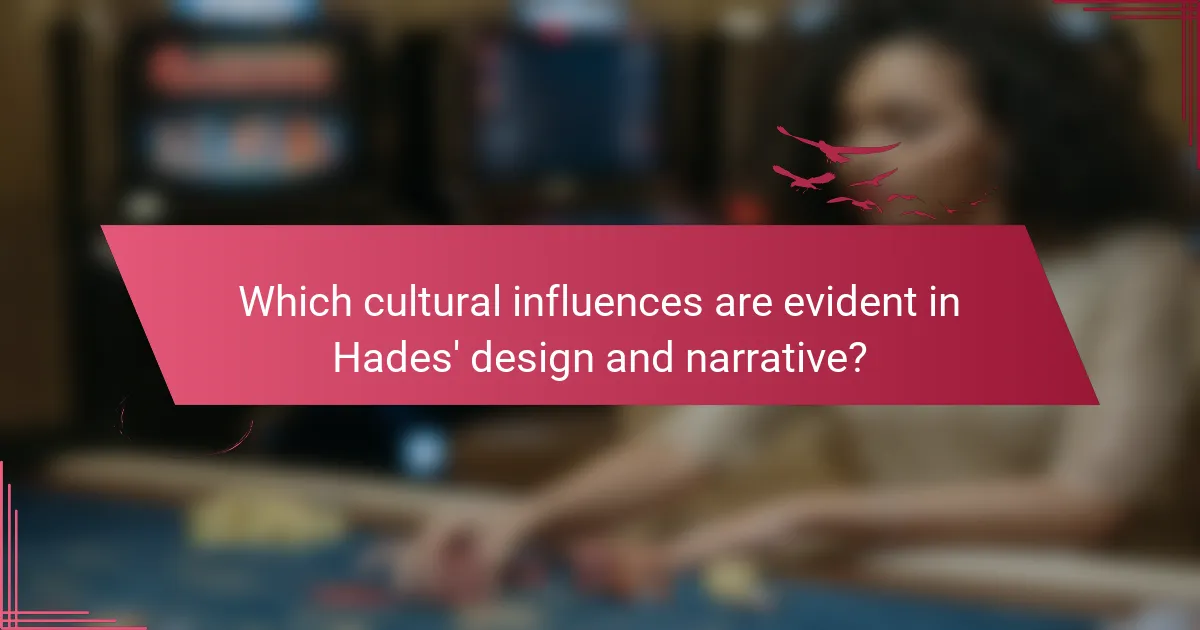
Which cultural influences are evident in Hades’ design and narrative?
Hades’ design and narrative reflect a blend of Greek mythology and modern storytelling techniques. The game draws heavily on ancient mythological figures, particularly focusing on Hades, Persephone, and various gods and heroes. This connection enriches the narrative, providing depth through character arcs that resonate with themes of family, fate, and rebellion. The art style incorporates vibrant colors and intricate designs, inspired by classical art yet infused with contemporary aesthetics. This unique combination creates an engaging experience that appeals to both mythology enthusiasts and gamers seeking innovative storytelling.
How does Hades reinterpret Greek mythology for modern audiences?
Hades reinterprets Greek mythology for modern audiences by blending traditional narratives with contemporary themes. The game explores complex characters, such as Hades and Persephone, presenting them with emotional depth and relatable struggles. This fresh perspective allows players to engage with mythological stories in a way that resonates with current societal issues, such as family dynamics and personal growth. The art style enhances this reinterpretation, featuring vibrant visuals that reflect both the underworld’s dark themes and the warmth of human connection. Through its narrative structure, Hades invites players to experience mythology not just as ancient tales but as living stories with relevance today.
What impact did cultural context have on character representation in Hades?
Cultural context significantly influenced character representation in Hades by integrating Greek mythology with modern themes. The game’s characters reflect diverse traits and complexities, showcasing their struggles and relationships. This approach humanizes mythological figures, allowing players to connect with them on a personal level. Unique attributes, such as character backstories and dialogue, enrich the narrative, making each character relatable within contemporary contexts. The art style further enhances this representation, blending traditional aesthetics with vibrant, modern visuals that resonate with a broad audience.
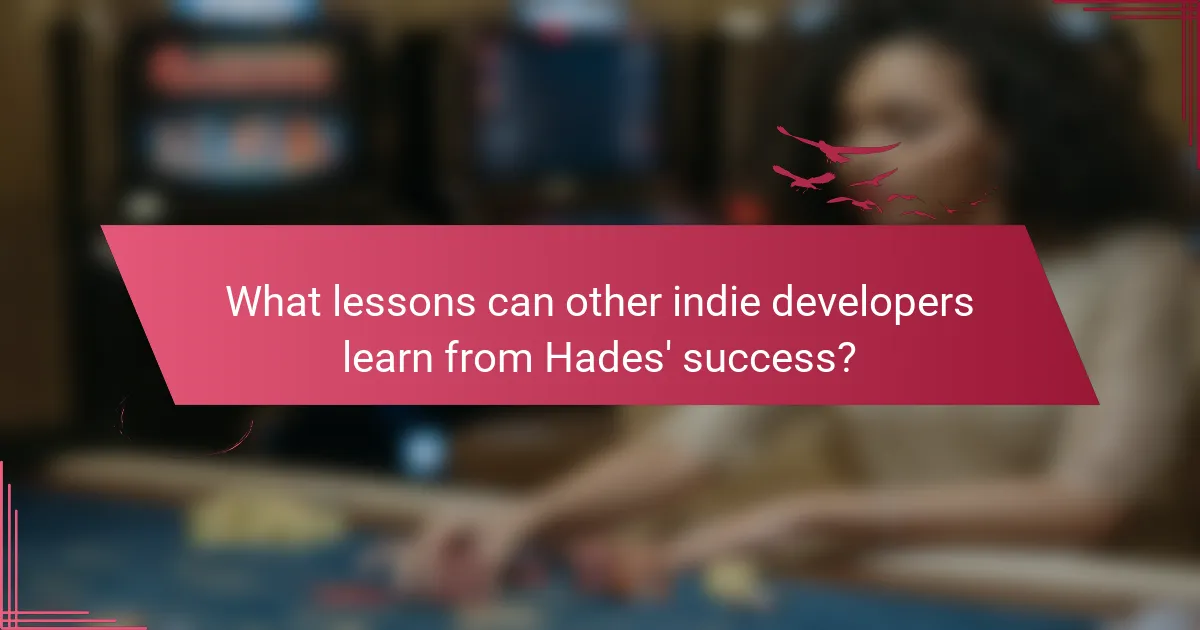
What lessons can other indie developers learn from Hades’ success?
Indie developers can learn several key lessons from Hades’ success. First, prioritize narrative structure to engage players emotionally. Hades employs a rich, character-driven story that evolves with gameplay, enhancing player investment. Second, focus on distinctive art style; the vibrant visuals and unique character designs set Hades apart, making it memorable. Third, embrace iterative development; Hades benefited from early access feedback, allowing developers to refine gameplay mechanics. Finally, cultivate a passionate community; Hades’ developers actively communicated with fans, creating a loyal player base that contributed to its success.
What common pitfalls should indie developers avoid based on Hades’ journey?
Indie developers should avoid overextending their scope, neglecting player feedback, and underestimating marketing. Focus on a clear narrative structure, as seen in Hades, which enhances player engagement. Ensure art style aligns with gameplay to create a cohesive experience. Prioritize community building to foster support and visibility.
How can storytelling and art style be integrated effectively in indie games?
Storytelling and art style can be integrated effectively in indie games by creating a cohesive narrative experience. In “Hades,” the narrative structure enhances player engagement through character development and emotional arcs. The unique art style, inspired by Greek mythology, visually complements the storytelling, making the world immersive. The synergy between narrative and visuals fosters deeper connections, encouraging players to explore the game’s themes and characters. This integration ultimately contributes to the game’s critical and commercial success.
What are the best practices for engaging with a gaming community?
Engaging with a gaming community involves active participation, transparency, and respect. First, communicate regularly through social media and forums. Second, encourage feedback and respond to player concerns. Third, share behind-the-scenes content to foster connection. Fourth, host events or contests to boost interaction. Finally, recognize and celebrate community contributions to build loyalty.

